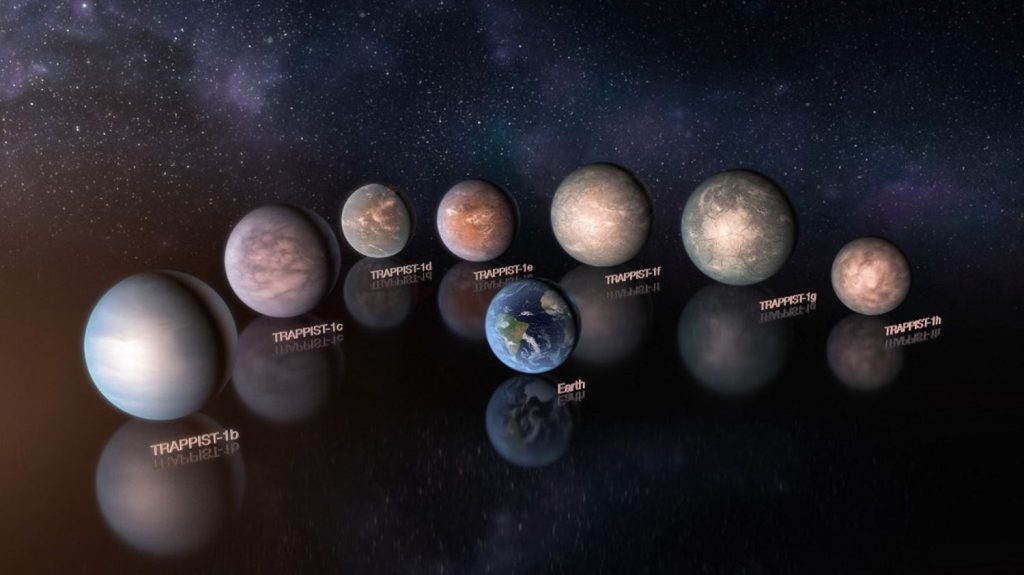
Four questions about Trappist-1, this planetary system that could harbor life 39 light years from Earth
Excitement is at its most extreme within the scientific community. The James Webb Telescope began observing the system of seven exoplanets that were discovered in 2017. This group of planets, similar to Earth and located around a star, can meet the basic requirements for the possible existence of life forms. Franceinfo explains why, with Trappist-1, researchers have their heads for the stars more than ever.
1What is Trappist-1?
In 2017, aAn international team led by Belgian researchers from the University of Liege discovers There are seven exoplanets, all close to the size of Earth. They orbit Trappist-1, a dwarf star located 39 light-years from our solar system. Why “Trappist”? In honor of the telescope of the same name located in Chile that made this observation…also in reference to a Belgian beer.
“Trappist-1 is a red dwarf, when our sun is a yellow dwarf”, explains to franceinfo Philippe Delorme, researcher at the Institute of Planetology and Astrophysics in Grenoble (IPAG). It is ten times less massive than our star. red dwarfs “They are the smaller and fainter stars; about 80% of the stars are red dwarfs, but none of them can be seen with the naked eye from a land”details Futura Science.
2What are the characteristics of these planets?
The seven planets (baptized b, c, d, e, f, g, h) are rocky rather than gaseous, like Jupiter or Saturn. These seven planets are very close to their star. “If we had to compare with our own solar system, it would be as if they were in the orbit of Mercury”, explains in France Info Marc Olivier, astronomer and director of the Institute of Astrophysics Space in Orsay (Esson). This means that they orbit Trappist-1 in a very short time, between a day and a half, for the closest reports, and 19 days, for the farthest, Parisian.
Another feature: This system is located less than forty light-years from Earth. Knowing that a light year is about 9,500 billion km, Trappist-1 is approximately 370,000 billion km away from us.
“It’s a suburb very close to Earth, when we know that our galaxy, the Milky Way, measures 100,000 light-years away.”
Mark Oliver, astronomer and director of the Institute for Space Astrophysicsin franceinfo
Finally, these planets are aligned, that is, they lower the luminosity of the star when it makes its revolution, “making it easier for them to study”Philip Delorme adds.
3Why does this system excite the scientific community?
Several thousand exoplanet systems have already been discovered in space since the first in 1995, But this arouses particular enthusiasm. “There is a correlation between the presence of planets in the habitable zone of a star and the observational ability of James Webb”confirms Philippe Delorme. “It’s the closest physical system to Earth, with planets that look like it and aligned”he adds.
Three of the planets, e, f and g, min Parisianso fall in “habitable area” Trappist-1, meaning that it is neither too close nor too far from it, which provides suitable temperatures for the presence of liquid water on its surface.
“It does not mean that there is life, but it does mean that it is not absurd to think about it.”
Philippe Delorme, researcher at the Institute of Planetary Science and Astrophysics in Grenoblein franceinfo
the system Trappist-1 is uniqueconfirms to AFP Olivia Lim, a doctoral student at the University of Montreal. All, or almost all, conditions there are favorable for the search for life outside our solar system.”
However, if there was life, it could be very different from what we know on Earth, because the rotation of the planets on themselves and their revolution around Trappist-1 can be synchronous. As for our moon, of which we always see the same face, the star will see only one face of the planets, Mark Oliver explains, Then it will be an eternal day for this side and an eternal night for the other.”
4Why is James Webb changing the game?
If the TRAPPIST telescope in Chile could find them, it couldn’t go much further. James Webb can. “against’It really is the perfect tool for studying the Trappist-1 planetary system, a star that emits primarily infrared radiation, as the James Webb Infrared Space Telescope”emphasize Parisian Michael Gillon, Astronomer at the University of Liege. Thanks to his more advanced instruments, he will be able to determine whether these planets have an atmosphere, and if so, he will be able to determine their composition.
How ? By observing the planets as they pass around the star, meaning that they pass in front of it, from our point of view. With each pass of a planet in front of Trappist-1, James Webb will be able to observe the star’s declining luminosity, but also to smash its light, by spectroscopy, just as a rainbow divides sunlight into several colours. .
By multiplying the notes, James Webb will be able to determine the possible existence From the effects of biomarkers, Slither Philip Delorme, or the presence of a gas or group of gases that we detect in the atmosphere, which we cannot explain by anything other than the existence of a form of life.” The presence of methane and oxygen, as on Earth, would be really exciting.”deduce the world.

“Incurable web evangelist. Hipster-friendly gamer. Award-winning entrepreneur. Falls down a lot.”
